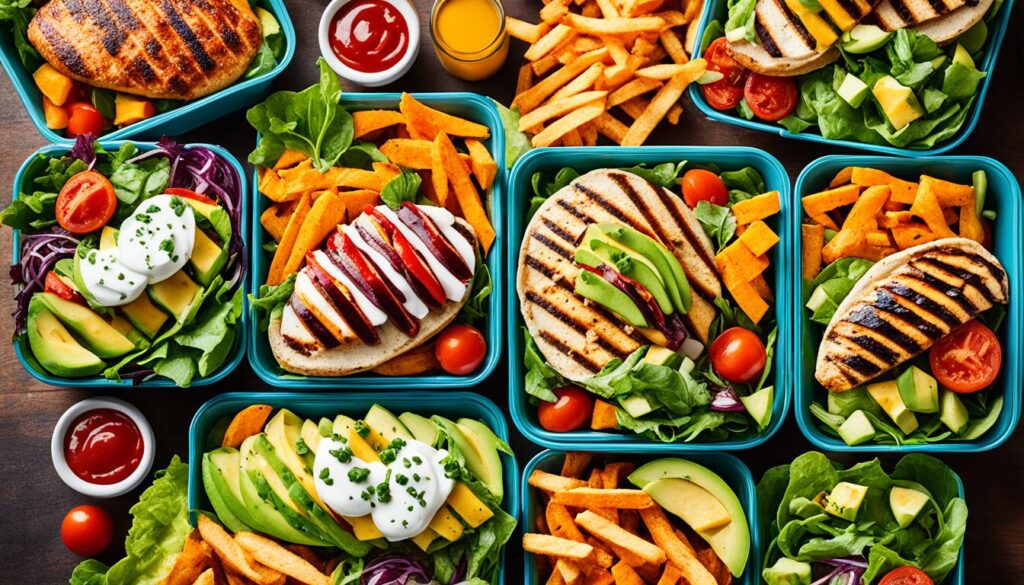Can you really lose weight by eating McDonald’s? Many people believe that fast food and weight loss are incompatible. However, one man’s experiment challenges this notion and raises questions about the true relationship between fast food and weight loss.
Kevin Maginnis, a 56-year-old man, set out on a weight loss journey with a unique approach. His goal was to shed pounds by consuming only McDonald’s food for 100 days. Maginnis was motivated by his desire to improve his health for the sake of his family. While many nutritionists warn against a diet centered around fast food due to the potential for nutrient deficiencies and sluggishness, Maginnis took a different approach.
Instead of indulging in the usual portion sizes, Maginnis restricted himself to consuming only half of each meal. He also waited until he felt genuine hunger before eating and focused on controlling his portions. Despite skepticism from others, Maginnis achieved remarkable results. In the first 50 days of his experiment, he successfully lost 38 pounds.
Maginnis’ experiment challenges the common belief that fast food and weight loss are incompatible. While it may seem counterintuitive, his approach of portion control and making conscious choices within the McDonald’s menu proved to be effective for him.
The Obesity Epidemic in the United States
Obesity is a significant health issue in the United States, with one in three adults and one in five children being affected. The prevalence of obesity has steadily increased over the years, leading to various health problems such as heart disease, stroke, Type 2 diabetes, and certain types of cancer. It is important to address obesity and find sustainable ways to combat it. While fast food is often associated with weight gain, Maginnis’ experiment challenges the belief that it is impossible to lose weight while eating McDonald’s.
According to data from the Centers for Disease Control and Prevention (CDC), more than 42% of adults in the United States are considered obese. This alarming statistic highlights the urgent need to address this epidemic and promote healthy lifestyles.
“Obesity is a complex issue influenced by various factors such as genetics, environment, and individual behaviors,” states Dr. Emily Foster, a renowned obesity specialist. “While it is true that fast food consumption is often linked to obesity, it is not the sole cause. It is essential to adopt a holistic approach to weight management that includes a balanced diet, regular physical activity, and behavioral changes.”
Contrary to popular belief, not all fast food choices are high in calories or unhealthy. Many fast food chains have incorporated healthier menu options and provide nutritional information to help consumers make informed choices. By making smart selections and practicing moderation, it is possible to enjoy fast food without compromising your health goals.
Maginnis’ experiment serves as an eye-opener, showcasing that weight loss can be achieved even with a fast food diet. It sheds light on the importance of mindful eating, portion control, and overall calorie balance when it comes to weight management.
Understanding the Link Between Fast Food and Obesity
Fast food consumption has often been associated with the rising obesity rates in the United States. The convenience, affordability, and widespread availability of fast food have contributed to its popularity and overconsumption. However, it is important to note that obesity is a multifaceted issue influenced by various factors beyond fast food alone.
A study published in the American Journal of Clinical Nutrition found that the association between fast food consumption and obesity is primarily attributed to its high calorie and fat content. Regularly consuming high-calorie foods without adequate physical activity can lead to weight gain over time. However, it is crucial to recognize that it is the overall dietary pattern and lifestyle choices that primarily contribute to obesity, rather than specific food items or brands.
To combat obesity, it is essential to adopt healthier eating habits and lifestyle changes that promote weight management and overall well-being. Making informed food choices, incorporating physical activity into daily routines, and seeking professional guidance are key steps towards achieving and maintaining a healthy weight.
| Consequences of Obesity | Obesity Statistics in the United States |
|---|---|
| Heart disease | 42% of adults considered obese |
| Stroke | 35% of adults overweight |
| Type 2 diabetes | 20% of children considered obese |
| Certain types of cancer | 1 in 3 adults affected by obesity |
Maginnis’ Unique Approach to Weight Loss
While the documentary “Super Size Me” highlighted the negative health effects of consuming only McDonald’s food, Kevin Maginnis took a different approach to achieve his weight loss goals. He recognized the importance of portion control and made conscious choices within the McDonald’s menu to create a calorie deficit while still enjoying his meals.
Maginnis implemented several strategies to make healthier choices at McDonald’s. Instead of a sausage patty, he opted for a chicken patty, which is lower in calories and saturated fat. He also chose water over soda, reducing his calorie and sugar intake. These simple modifications allowed him to stay within his calorie goals while still savoring the taste of McDonald’s food.
McDonald’s offers a variety of menu items that can fit into a balanced and healthy diet. They have expanded their menu to include options like salads, grilled chicken sandwiches, and fruit cups. By choosing these items, individuals can enjoy a meal at McDonald’s without compromising their health or weight loss goals.
| Menu Item | Calories | Total Fat (g) | Saturated Fat (g) | Sodium (mg) |
|---|---|---|---|---|
| Grilled Chicken Sandwich | 370 | 7 | 2.5 | 820 |
| Hamburger | 250 | 8 | 3.0 | 520 |
| Side Salad | 15 | 0 | 0 | 20 |
| Fruit ‘n Yogurt Parfait | 150 | 2 | 1.5 | 65 |
The Results of Maginnis’ Experiment
Throughout his 100-day experiment, Kevin Maginnis documented his progress on TikTok, providing a real-time account of his weight loss journey. By the halfway point, Maginnis had already lost an impressive 38 pounds, showcasing the effectiveness of his unique approach.
In addition to shedding pounds, Maginnis’ experiment also had a positive impact on his overall health. His bloodwork revealed improvements in various biomarkers, including cholesterol and triglyceride levels. These results further support Maginnis’ belief that obesity, rather than specific foods, is the main contributor to health issues.
While it’s important to note that Maginnis’ approach may not be suitable for everyone, it highlights the significance of two key factors in weight loss: portion control and making conscious choices when eating out.
The Importance of a Balanced Approach to Weight Loss
While Kevin Maginnis’ experiment demonstrates the possibility of losing weight while eating McDonald’s, it is crucial to adopt a balanced approach to weight loss. Signe Svanfeldt, a nutritionist, emphasizes the importance of a varied and balanced diet that provides all the necessary nutrients for optimal well-being.
To achieve sustainable weight loss, it is essential to incorporate a range of nutrient-rich foods into your meals, including fiber, unsaturated fats, protein, vitamins, and minerals. While occasional indulgences are acceptable, focusing on healthier choices and controlling portion sizes are key.
The Benefits of a Balanced Approach
A balanced approach to weight loss offers several benefits. By incorporating a variety of nutrient-rich foods, you can:
- Support your overall health and well-being
- Maintain energy levels throughout the day
- Promote a healthy metabolism
- Reduce the risk of nutrient deficiencies
- Enhance the body’s ability to burn calories efficiently
By paying attention to the nutritional content of your meals, you can make healthier choices and ensure that your body receives the essential nutrients it needs for optimal function.
Eating Healthy at McDonald’s
Contrary to popular belief, fast food restaurants like McDonald’s offer healthy options that can be incorporated into a balanced diet. When choosing meals at McDonald’s, consider the following:
“When dining at McDonald’s, opt for grilled chicken sandwiches or salads with lean protein, plenty of vegetables, and a lighter dressing. Avoid deep-fried items or those high in added sugars and opt for water or unsweetened beverages instead of sugary drinks.” – Signe Svanfeldt, Nutritionist
By making mindful choices and being aware of the nutritional content of the food you consume at McDonald’s, you can enjoy a meal that aligns with your weight loss goals.

| Healthy Fast Food Options at McDonald’s | Calories | Protein (g) | Total Fat (g) | Saturated Fat (g) | Carbohydrates (g) | Sodium (mg) |
|---|---|---|---|---|---|---|
| Grilled Chicken Sandwich | 350 | 29 | 9 | 2.5 | 42 | 820 |
| Side Salad | 15 | 1 | 0.5 | 0 | 3 | 10 |
| Fruit ‘N Yogurt Parfait | 150 | 4 | 2 | 1 | 30 | 85 |
| Grilled Chicken Salad | 220 | 34 | 6 | 2 | 9 | 890 |
| Apple Slices | 15 | 0 | 0 | 0 | 4 | 0 |
These are just a few examples of healthier options available at McDonald’s. By choosing nutrient-dense meals and snacks, you can incorporate fast food into your weight loss journey while still prioritizing your health.
Debunking Food Myths and Labels
There is a common misconception that certain foods, such as fast food or sugary treats, are inherently “bad” for weight loss. However, the truth is that weight gain or loss is determined by overall calorie intake and expenditure. Consuming a certain food in moderation within a balanced diet does not automatically lead to weight gain. It is important to understand that all foods can be part of a healthy eating plan when consumed in appropriate portions and in the context of overall calorie balance.
Weight loss eating McDonald’s is often seen as an oxymoron, but Kevin Maginnis’ experiment challenges this belief. By focusing on portion control and making healthier choices within the fast-food menu, Maginnis successfully lost 38 pounds in the first 50 days of his experiment. This demonstrates that it’s possible to achieve weight loss goals even while enjoying fast food.
The Role of Portion Control
One of the key factors in Maginnis’ weight loss journey was his emphasis on portion control. By eating only half of the McDonald’s meal, he was able to create a calorie deficit without completely eliminating fast food from his diet. This shows that it’s not necessarily the food itself that leads to weight gain but rather the amount consumed.
Maginnis’ approach highlights the importance of being mindful of portion sizes when eating fast food. By enjoying smaller portions, individuals can still indulge in their favorite treats without sabotaging their weight loss efforts.
Conscious Choices within the Fast Food Menu
Another aspect of Maginnis’ experiment was his conscious selection of healthier options within the McDonald’s menu. He opted for a chicken patty instead of a sausage and chose water over soda. This demonstrates that small changes in food choices can contribute to a healthier overall diet.
When dining at fast-food restaurants, individuals can make healthier choices by opting for grilled or baked options instead of fried ones. Including more vegetables and choosing beverages with fewer calories can also make a significant difference in calorie intake. By making mindful choices within the fast food menu, individuals can enjoy their meals while still working towards their weight loss goals.
| Calories (kcal) | Total Fat (g) | Saturated Fat (g) | Sodium (mg) | Sugar (g) | |
|---|---|---|---|---|---|
| Big Mac | 540 | 28 | 10 | 950 | 9 |
| Grilled Chicken Sandwich | 350 | 9 | 3.5 | 900 | 6 |
| French Fries (medium) | 320 | 15 | 2 | 160 | 0 |
| Side Salad | 15 | 0 | 0 | 10 | 2 |
| Diet Coke (medium) | 0 | 0 | 0 | 40 | 0 |
The table above showcases the calorie and nutrient content of selected McDonald’s menu items. It is evident that there are healthier options available that can fit into a balanced eating plan. By making informed choices and being mindful of calorie intake, individuals can enjoy fast food while still working towards their weight loss goals.
The Danger of Restrictive Diets
Restrictive diets that categorize foods as “good” or “bad” can have detrimental effects on our relationship with food. These diets often lead to an unhealthy mindset and can even result in binge eating or other disordered eating patterns.
It is important to adopt a more flexible and sustainable approach to eating. This means including a variety of foods in our diet and allowing ourselves to indulge in occasional treats. By focusing on portion control, making conscious choices, and maintaining a balanced diet overall, we can achieve long-term weight loss success without feeling deprived or restricted.
Instead of demonizing certain foods or food groups, it’s more beneficial to focus on overall nutrition and calorie balance. This means incorporating nutrient-rich foods into our meals and being mindful of our portion sizes.
To navigate weight loss while eating out, especially at fast food restaurants, it is essential to have some strategies in place:
- Opt for healthier options on the menu, such as grilled chicken instead of fried, and choose salads or vegetable sides over French fries.
- Watch out for added sugars and dressings that can increase calorie intake.
- Drink water or unsweetened beverages instead of sugary sodas.
- Avoid supersized or extra-large portions, and instead, opt for smaller sizes or share meals with a friend.
By following these tips and maintaining a balanced and mindful approach to our eating habits, we can enjoy our meals while still making progress towards our weight loss goals.
Conclusion
Weight loss and fast food are often seen as contradictory concepts, but Kevin Maginnis’ experiment challenges this belief. His 100-day journey of eating only McDonald’s food showcased that it is possible to lose weight while enjoying fast food. However, it is crucial to approach weight loss with a balanced and sustainable perspective.
Portion control plays a vital role in achieving weight loss goals. Maginnis successfully lost 38 pounds in the first 50 days of his experiment by cutting his meal portions in half. This approach allows for indulgence in your favorite fast food items while still creating a calorie deficit.
Furthermore, making healthier choices within the fast-food menu is essential. Opting for grilled chicken instead of fried options, choosing water over sugary drinks, and incorporating more salads or vegetables into your meals can contribute to a more balanced diet. By focusing on overall calorie balance and making conscious choices, individuals can achieve long-term weight loss success.
It is important to remember that there is no such thing as “good” or “bad” food. What matters is the overall pattern of eating and making informed decisions about portion sizes and nutrient-rich options. By maintaining a balanced approach and incorporating a variety of foods, including fast food in moderation, individuals can achieve their weight loss goals and improve their overall well-being.
FAQ
Can you lose weight by eating McDonald’s?
Yes, it is possible to lose weight while eating McDonald’s. Kevin Maginnis’ 100-day experiment showed that by practicing portion control and making healthier choices within the McDonald’s menu, he was able to successfully lose weight.
Was Kevin Maginnis’ weight loss sustainable?
While Maginnis’ weight loss during the 100-day experiment was significant, it is important to approach weight loss with a balanced and sustainable perspective. Portion control and overall calorie balance are key factors in achieving long-term weight loss success.
Can fast food be a part of a healthy eating plan?
Yes, all foods can be part of a healthy eating plan when consumed in appropriate portions and in the context of overall calorie balance. It is important to focus on making conscious choices and maintaining a balanced diet overall.
Are all fast food options unhealthy?
While fast food is often associated with unhealthy choices, many fast food chains, including McDonald’s, now offer healthier menu options. By choosing low-calorie and nutrient-rich meals, it is possible to make healthier fast food choices.
Do restrictive diets lead to sustainable weight loss?
Restrictive diets that categorize foods as “good” or “bad” can lead to an unhealthy relationship with food. It is crucial to adopt a flexible and sustainable approach to eating that includes a variety of foods and allows for occasional treats for long-term weight loss success.







